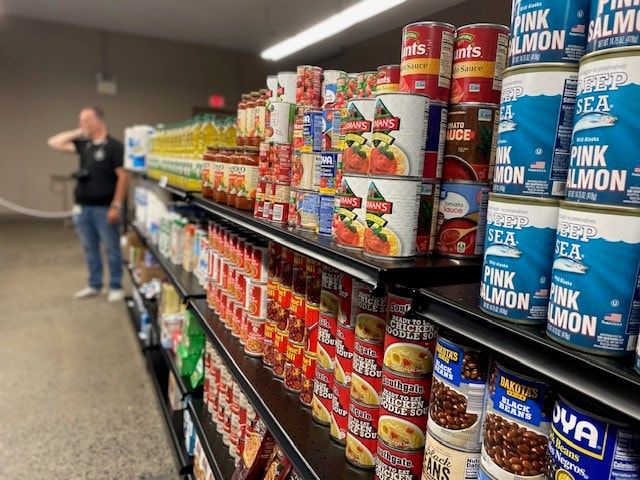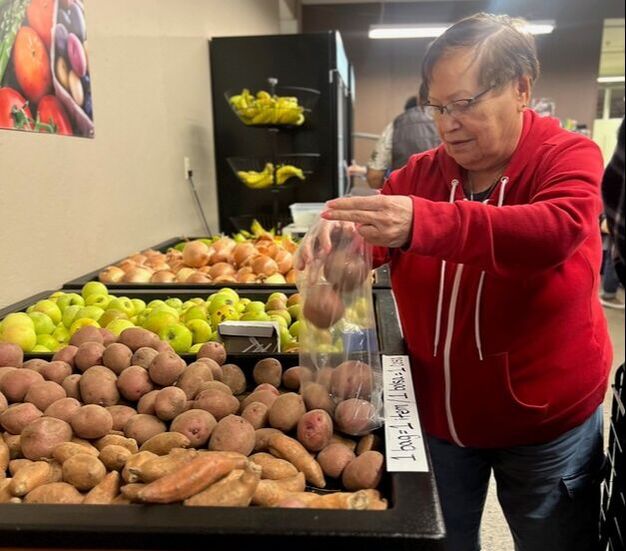We believe every person deserves access to healthy food and shelter.
Even before COVID-19, it was evident that food and housing insecurity was an issue in Lebanon County. Lebanon County Christian Ministries was already serving thousands of people throughout our food, clothing and shelter programs.
The economic fallout from the pandemic deepened poverty for many people and caused others to seek assistance for the first time.
The economic fallout from the pandemic deepened poverty for many people and caused others to seek assistance for the first time.
What does food insecurity look like in Lebanon County?Though closely related, there's a difference between food insecurity and hunger. The U.S. Department of Agriculture (USDA) defines food insecurity as a lack of consistent access to enough food for an active, healthy life. Hunger refers to a personal, physical sensation of discomfort, while food insecurity refers to a lack of available financial resources for food at the household level.
The overall food insecurity rate is about 9.8% in Lebanon County, according to Central Pennsylvania Food Bank's 2023 Hunger Mapping report. Children are 71% more likely to be food insecure than adults in Lebanon County, with a food insecurity rate of 14.4% compared to just 8.4% of adults. This is the 14th highest age disparity among all 67 counties in Pennsylvania, indicating that child food insecurity is a unique challenge in Lebanon County. The highest food insecurity areas in the county are concentrated in Lebanon city, West Lebanon, Palmyra, East Hanover and Myerstown. These areas contain 26% of the population of Lebanon County but 53% of all food insecure individuals. Lebanon city is home to 18% of the total population but 39% of all food insecurity individuals in the county. Very low food insecurity, which is characterized by reduced food intake, is extremely prevalent among food pantry visitors in Lebanon County. A staggering 41% of all food pantry visitors experience reduced food intake on a regular basis. |
| |||||||
"It helps me a great deal because food is so expensive. I live alone, so for me, it works out.”
- Shane, free noon meal guest
What does housing insecurity and homelessness look like in Lebanon County?
Food insecurity doesn't exist in a vacuum. Low-income individuals and families are affected by multiple, overlapping issues such as lack of affordable housing, social isolation, chronic or acute health problems, high medical costs and low wages. These factors also can lead to housing insecurity and homelessness.
Homelessness is defined in a number of different ways. At its core, homelessness is defined as an individual or family lacking a fixed, regular, and nighttime residence. When people think of homelessness, what often comes to mind are people who are living unsheltered on the streets in big cities. While this type of homelessness exists in Lebanon County, the overwhelming majority of people experiencing homelessness are living doubled up with other families, couch surfing (moving from one temporary housing arrangement to another) or are living in shelters, cars or hotels. A precise picture of homelessness in Lebanon County is difficult to obtain due to a lack of sufficient data collected. However, 611 students were identified as being homeless in some capacity in Lebanon County, according to a 2020-21 report.
In general, Lebanon County is in dire need of affordable rentals and for-sale housing, according to a massive Housing Needs Assessment conducted by Bowen National Research in 2023.
It appears that Lebanon County is most in need of affordable rental (less than $1,000 per month) and for-sale housing (less than $150,000) oriented toward families (two or more bedrooms) with incomes up to $60,000 annually. In addition, it appears that there is a considerable need for studio and one-bedroom housing, as well as senior care housing, primarily for seniors with low incomes/assets. Limited overall availability and rent affordability appear to be the most common housing issues experienced in Lebanon County, and as a result, the repair and revitalization of existing housing appears to be the top housing construction priority among respondents.
Among the special needs populations in the area, permanent supportive housing for persons with a disability, transitional housing for unaccompanied youth, and emergency shelters for the homeless were rated as the top needs, according to the report. Overall, the consensus of respondents is that the aforementioned housing issues cause residents of the area to live in substandard and unaffordable housing.
Read the full report here
Homelessness is defined in a number of different ways. At its core, homelessness is defined as an individual or family lacking a fixed, regular, and nighttime residence. When people think of homelessness, what often comes to mind are people who are living unsheltered on the streets in big cities. While this type of homelessness exists in Lebanon County, the overwhelming majority of people experiencing homelessness are living doubled up with other families, couch surfing (moving from one temporary housing arrangement to another) or are living in shelters, cars or hotels. A precise picture of homelessness in Lebanon County is difficult to obtain due to a lack of sufficient data collected. However, 611 students were identified as being homeless in some capacity in Lebanon County, according to a 2020-21 report.
In general, Lebanon County is in dire need of affordable rentals and for-sale housing, according to a massive Housing Needs Assessment conducted by Bowen National Research in 2023.
It appears that Lebanon County is most in need of affordable rental (less than $1,000 per month) and for-sale housing (less than $150,000) oriented toward families (two or more bedrooms) with incomes up to $60,000 annually. In addition, it appears that there is a considerable need for studio and one-bedroom housing, as well as senior care housing, primarily for seniors with low incomes/assets. Limited overall availability and rent affordability appear to be the most common housing issues experienced in Lebanon County, and as a result, the repair and revitalization of existing housing appears to be the top housing construction priority among respondents.
Among the special needs populations in the area, permanent supportive housing for persons with a disability, transitional housing for unaccompanied youth, and emergency shelters for the homeless were rated as the top needs, according to the report. Overall, the consensus of respondents is that the aforementioned housing issues cause residents of the area to live in substandard and unaffordable housing.
Read the full report here
| Housing Needs Assessment.pdf | |
| File Size: | 23525 kb |
| File Type: | |
"You have to find people that are going to help you look forward and pick you up and keep going."
- kelsey, former FRESH Start guest
A bigger issue
Food insecurity and homelessness are complex problems. More than 37% of households in Lebanon County can't afford the basic necessities, according to the ALICE report by our partners at the United Way. ALICE is an acronym that stands for "asset-limited, income-constrained, employed." ALICE earns above the Federal Poverty Level, but not enough to cover the costs of basic essentials. These basic necessities include food, housing, transportation, child care, healthcare and technology. Of the 54,522 households in Lebanon County, 14,650 fall under the ALICE category and 5,278 are below the Federal Poverty Level.
Your browser does not support viewing this document. Click here to download the document.
Take actionYou can help us put food on the table and provide shelter for those in need today.
|


